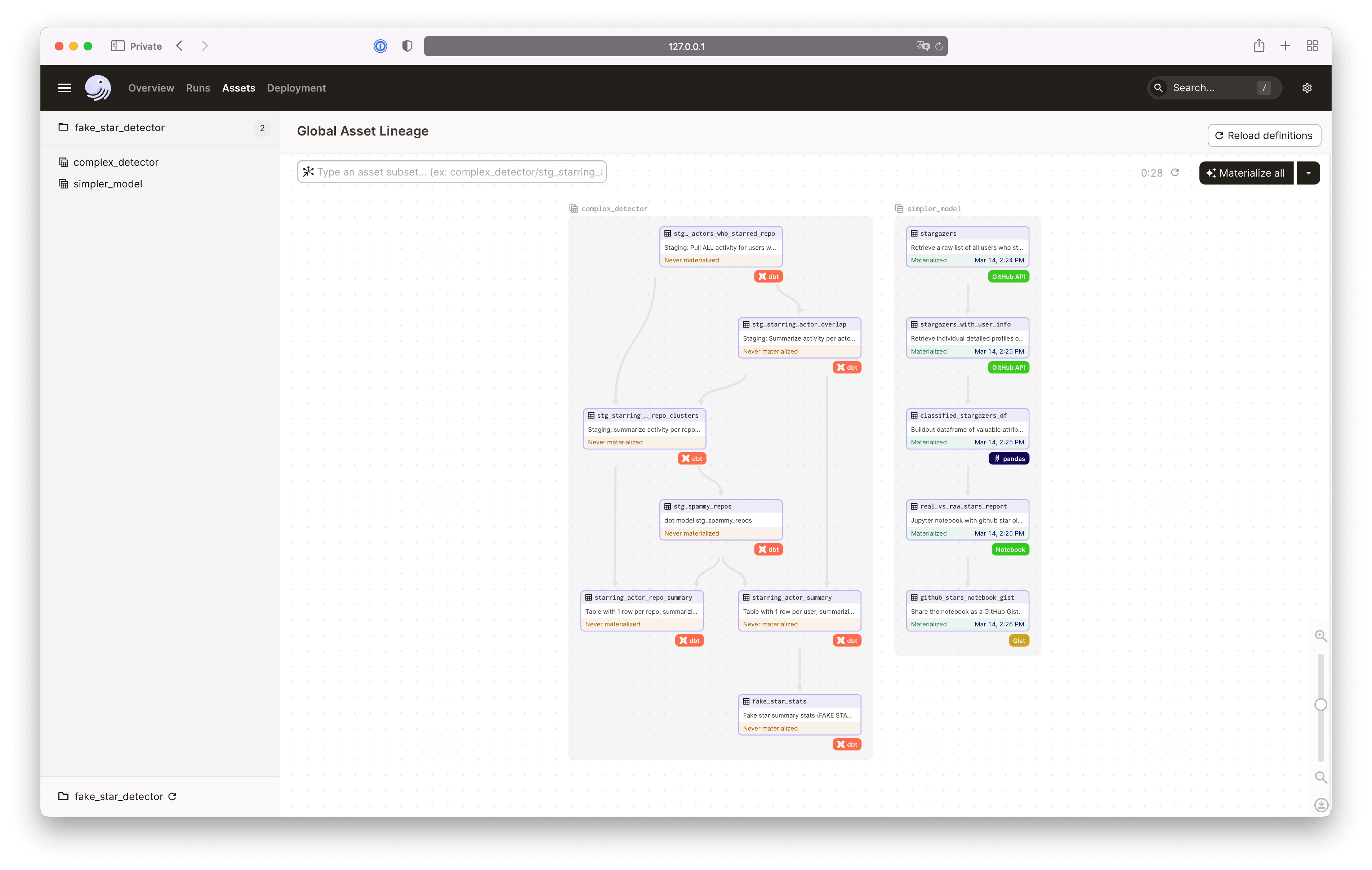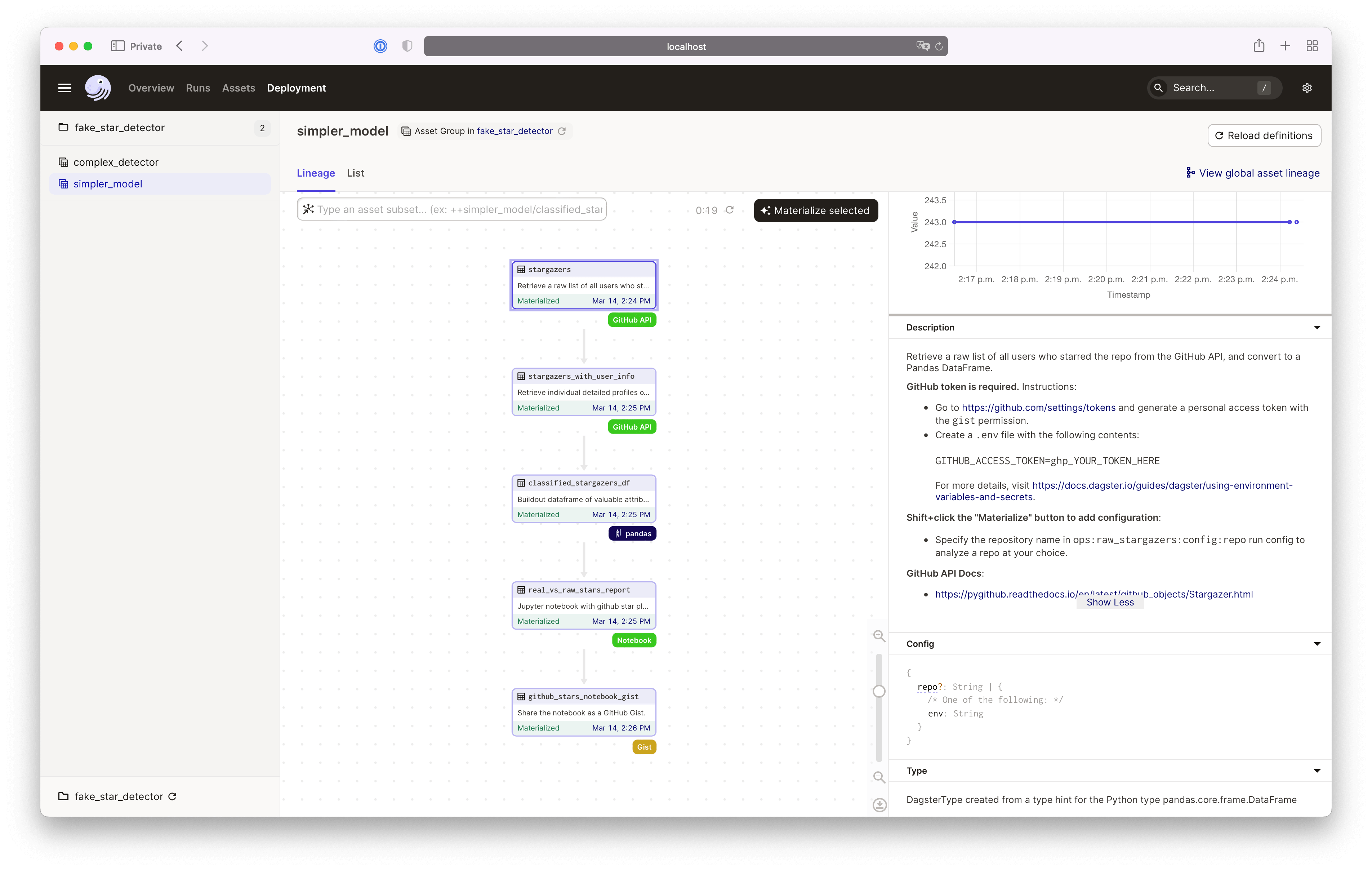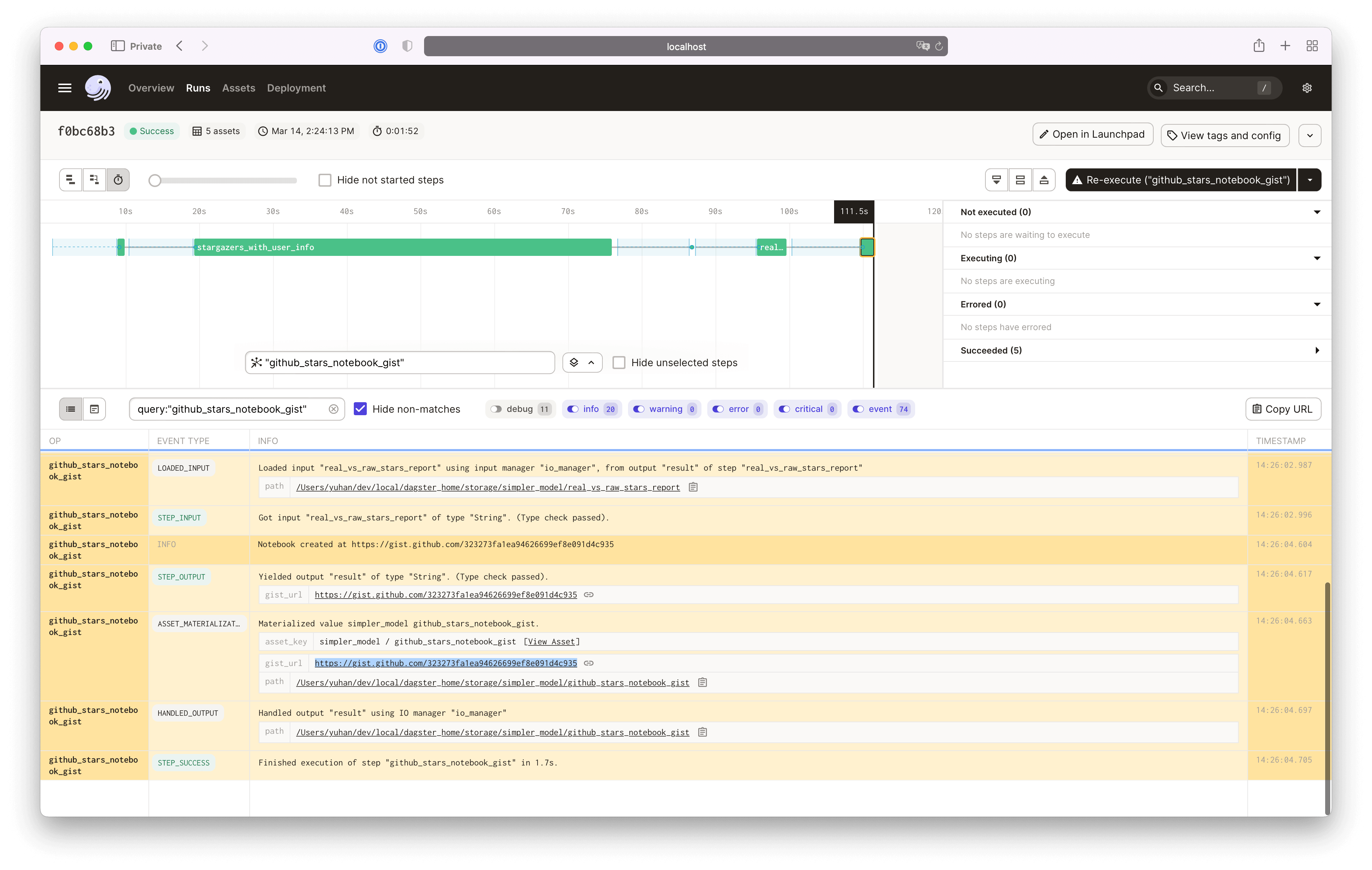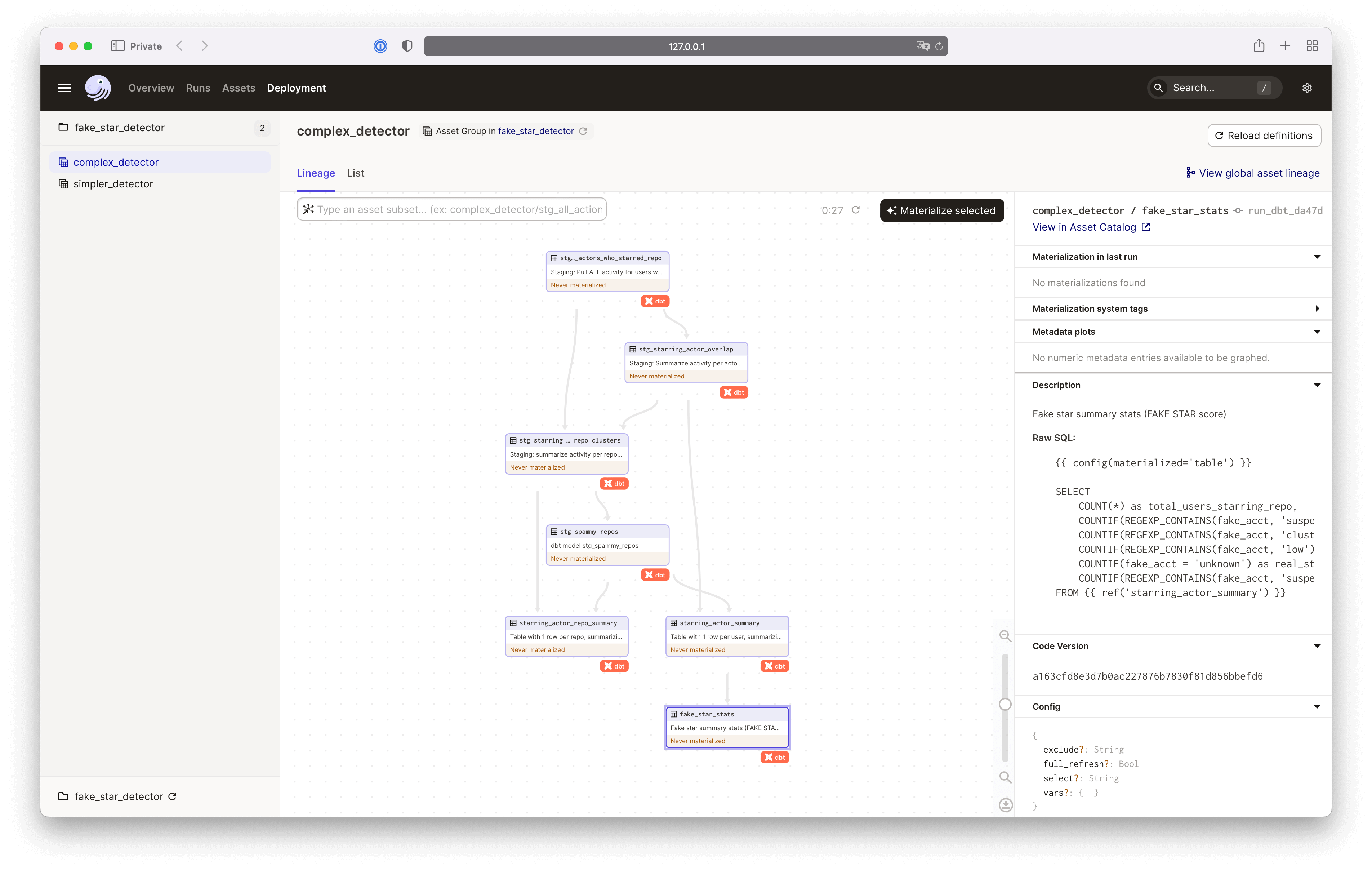This is a simple Dagster project to analyze the number of fake GitHub stars on any GitHub repository. It is a companion to the blog post found on the Dagster blog.
This project consists of two models:
-
Simpler model: A simple model running “low activity” heuristic. This simple heuristic can detect many (but hardly all) suspected fake accounts that starred the same set of repositories, using nothing but data from the GitHub REST API (via pygithub).
-
Complex detector: An alternative detection model which runs a sophisticated clustering algorithm as well as the heuristic, using the public GH Archive available in Bigquery. This model is written in SQL and uses dbt alongside Dagster.
- Note: You can run this within the limits of a free-tier BQ account, but the analysis will be reduced in scope. By default, this model only scans data in 2023 on a small repository, in order to make it stay within the free-tier quota.
- Table of contents
- Getting started
- Trying the simpler model using data from the GitHub API
- Running the complex model using BigQuery archive data
For this tutorial, we assume you have Git installed. Installation details can be found here: https://github.com/git-guides/install-git.
For running the simpler model, you will also need a GitHub Personal Access token to access the GitHub API. This can be created in GitHub here: https://github.com/settings/tokens (after logging in to GitHub). Keep the new access token handy as we will be needing it shortly.
Note: we'll need gist scope because we're going to create a Gist to be the final report in the end.
In order to run the complex model which uses BigQuery public archive data, you will need to have a BigQuery account to run the dbt models. You can sign up for a free account here. Check out Create a Google Service Account to learn how to create a service account and download the JSON key file. This also requires BigQuery API enabled in your service account.
You will need to pull a copy of this repository onto your local machine, go into the top level of the cloned repository and run the install command:
git clone https://github.com/dagster-io/fake-star-detector.git
cd fake-star-detector
Install Dagster and our other dependencies - see https://docs.dagster.io/getting-started/install
python3 -m venv venv
source venv/bin/activate
pip install -e ".[dev]"
Note for M1 Mac users you may need to use pip install dagster dagit --find-links=https://github.com/dagster-io/build-grpcio/wiki/Wheels
Start the Dagster UI web server:
dagster dev
Open http://localhost:3000 with your browser to see the project.
Note: If you have previously installed Dagster on your system, you may encounter the error Error: No such command 'dev'.. If this is the case, your system is likely trying to access the Dagster install outside of your venv. Try running the bash command rehash which will Recompute the internal hash table for the PATH variable, then repeat the dagster dev command.
Next, you can run the detection model(s) of your own choice.
- Simple, more complete history, and no cost: Simpler model -- This model uses data from the GitHub API to detect fake stars. You may hit GitHub API limit depending on how many activities the repository you choose to analyze.
- Comprehensive, but shorter period at free-tier: Complex model: This model uses the public GH Archive available in Bigquery. You can specify a longer time span and a larger repository to analyze, but it may get expensive as you scan more data in BigQuery.
You can use the below steps to bring up dagster-dev instance using a local docker image
-
install Docker from https://docs.docker.com/get-docker/
-
in the file docker-compose.yaml, set the value of your github token under environment. Refer to the instructions above for how to obtain your own token.
environment: - GITHUB_ACCESS_TOKEN=<<GITHUB_ACCESS_TOKEN>> -
run the command
docker compose up -d --build -
browse the link http://localhost:3000 to see the project
This model requires GitHub Access Token to access the GitHub API. Refer to the instructions above for how to obtain your own token. (If you are using Docker you can skip this step as you should have already set the token in earlier step)
Then, create a .env file at the root of the repository you just cloned and add your GitHub access token as a variable:
GITHUB_ACCESS_TOKEN=<<GITHUB_ACCESS_TOKEN>>
Navigate to simpler_model from the left nav in the UI. This defaults to analyze a small repository frasermarlow/tap-bls. You can click "Materialize all" to kick off the model and check out the result. At the end of the job, it will output a Gist summarizing the analysis, such as this URL. You can find the link in the compute log:
You can also specify a different repo by Shift+clicking "Materialize all" on the asset graph page to specify it in the configuration, such as:
ops:
stargazers:
config:
repo: <insert name of the repo to analyze>| Shift+click "Materialize all" | Config editor |
|---|---|
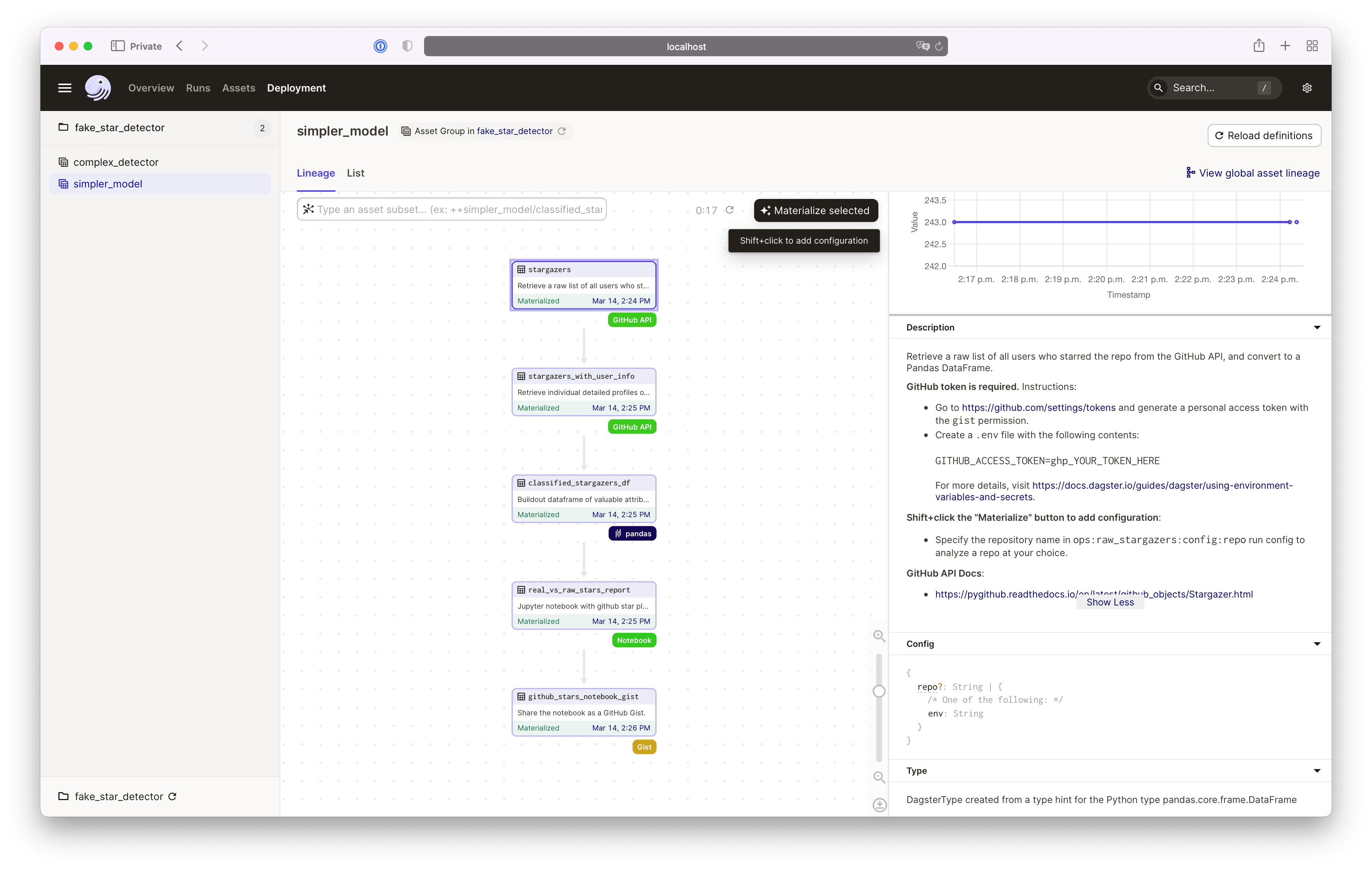 |
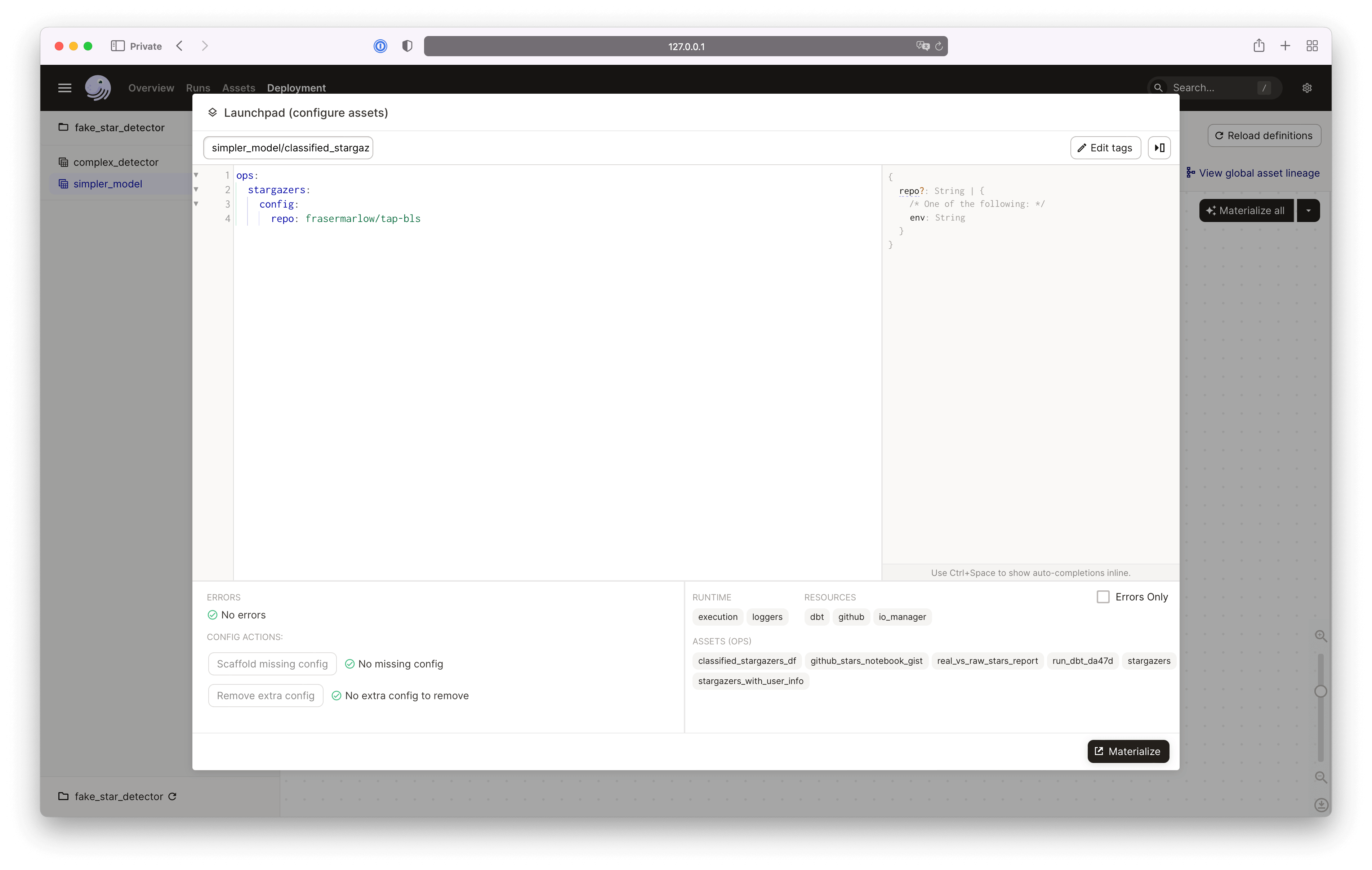 |
Then, click "Materialize" to kick off the simple model. In the end, you'll get a GitHub Gist with the results.
If you are using the default Dagster storage backed by SQLite, you may encounter an error as:
sqlalchemy.exc.OperationalError: (sqlite3.OperationalError) unable to open database file
To get your pipeline successfully running, you can Shift+click "Materialize all" on the asset graph page and add the following configuration. This will turn off the default multiprocessing execution.
execution:
config:
in_process: nullThis asset group is a Dagster project and involves 6 assets:
- Asset
stargazers: We call the GitHub API and retrieve a list of users who have starred the repo, and then turn the response into a Pandas DataFrame. - Asset
stargazers_with_user_info: We look up each user in turn and pull their detailed profile from the GitHub API. - Asset
classified_stargazers_df: We analyze each profile and match it against our heuristic to determine if they are fake or not, and output a Pandas DataFrame. - Asset
real_vs_raw_stars_report: We calculate the percentage of fake stars and output a report in raw Jupyter Notebook format. - Asset
github_stars_notebook_gist: We convert the raw Jupyter Notebook into a Gist and output the URL to the Gist.
In addition to the above, we have a few helper functions:
a) validate_star: Matching a profile against the heuristic
b) see_if_user_exists: Verifying that a user still exists before pulling the full details
c) handle_exception: Handling exceptions for the GitHub API call. This op calls on get_retry_at which returns the x-ratelimit-resetvalue for the GitHub API.
Currently, the pipeline will simply return a result in the Dagster UI as in INFO event type such as "Score is 12.34% fake stars" and will provide a list of usernames flagged as fake.
This model is written in SQL and uses dbt. You can find the dbt project in the dbt_project directory, and the dbt models in the dbt_project/models/complex_detector/ directory.
This model requires a BigQuery account and Google Search Account with BigQuery API enabled to access the source data. Refer to the above for instructions.
Next, you will need to add the credentials to your environment. You can do this by adding the following to your .env file:
DBT_BIGQUERY_KEYFILE_PATH='path to your JSON key file'
DBT_BIGQUERY_PROJECT='name of the bigquery project the output will write to'
DBT_BIGQUERY_DATASET='dbt_github_star' # or your desired bigquery dataset name
DBT_BIGQUERY_LOCATION='US' # or your desired location
Navigate to complex_detector in the UI. Click "Materialize all" to kick off the complex model. This defaults to analyze frasermarlow/tap-bls.
In the end, you'll get a few BigQuery tables with the final result:
| Tables and views in BigQuery | Final result |
|---|---|
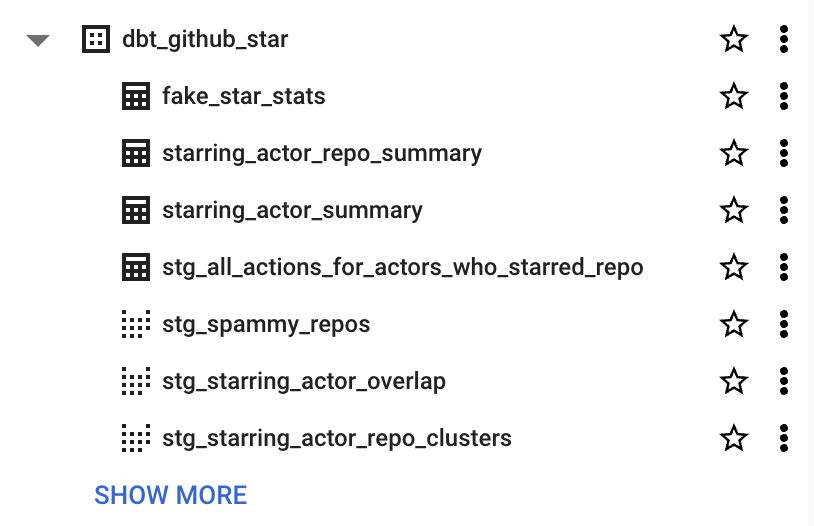 |
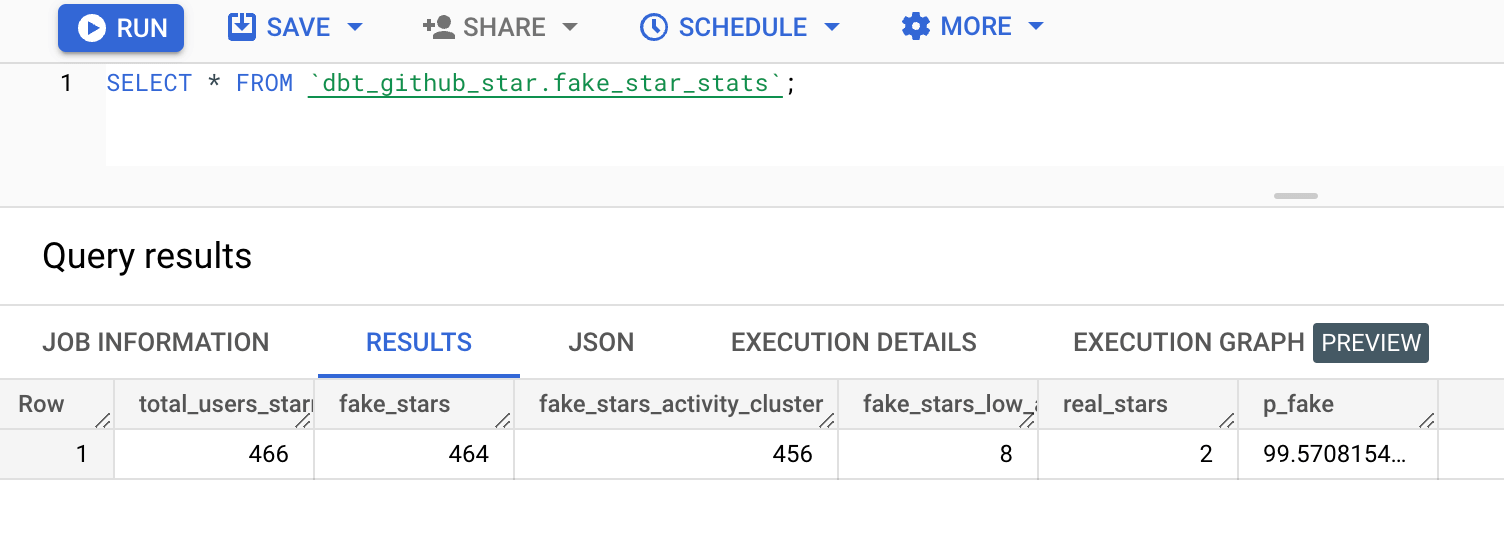 |
To check out for another repository, edit the "target_repo" in ./dbt_project/models/fake_star_detector/stg_all_actions_for_actors_who_starred_repo.sql:
{% set target_repo = 'frasermarlow/tap-bls' %}
This loads a dbt project which uses GitHub Archive data to identify suspicious users who starred the given repository, and estimates a FAKE STAR score for that repository using two separate heuristics to catch different types of fake accounts.
The dbt project materializes 4 BigQuery tables with estimated FAKE STAR score, and a few staging views:
stg_all_actions_for_actors_who_starred_repo: all activity for users who starred repo in the given time periodstarring_actor_summary: table with 1 row per user, summarizing similarity to other users in a set.starring_actor_repo_summary: table with 1 row per repo, summarizing similarity to other repositories actors touched.fake_star_stats: fake star summary stats (FAKE STAR score).
